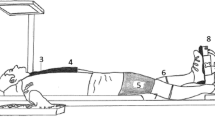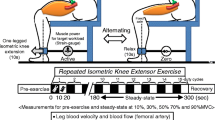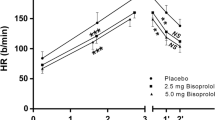Summary
The effect of β-adrenergic blockade on torque output and leg blood flow was examined in seven healthy young men during repeated maximal isometric voluntary contractions of the triceps surae muscle group. Exercise was performed in either a bent- or straight-leg position during each of four drug treatments: placebo, propranolol, metoprolol, oxprenolol. Contractions were sustained for 5 s with 5 s relaxation for a total of 10 min followed by a 10-min recovery. Leg blood flow was measured during the 5 s relaxation separating contractions using strain gauge plethysmography. Torque output decreased during the 10-min contractions with no differences between the four drug treatments. Leg blood flow was lower with β-blockade during the initial stages of exercise and recovery in the bent-leg position but no differences were observed after 3 min exercise or recovery. Leg blood flow in the straight-leg position was not different between any of the four drug treatments, but it was significantly less than in bent-leg exercise. The lower blood flows during the initial stages of exercise in the β-blocked conditions probably reflect a slowing of the central cardiovascular response because of β1-receptor blockade of the heart rather than on the β2-receptors effects on peripheral vacular resistance. It is concluded that local vasodilator substances released from the working muscle may play a more important role than β2-receptor stimulation of smooth muscle in skeletal muscle resistance vessels in regulating local muscle blood flow during maximal exercise of the triceps surae muscle group.
Similar content being viewed by others
References
Andersen P, Saltin B (1985) Maximal perfusion of skeletal muscle in man. J Physiol (Lond) 366:233–249
Brick I, Glover WE, Hutchison KJ, Roddie IC (1966) Effects of propranolol on peripheral vessels in man. Am J Cardiol 18:329–332
Brick I, Hutchison KJ, McDevitt DG, Roddie IC, Shanks RG (1968) Comparison of the effects of I.C.I. 50172 and propranolol on the cardiovascular responses to adrenaline, isoprenaline and exercise. Br J Pharmacol 34:127–140
Epstein SE, Robinson BF, Kahler RL, Braunwald E (1965) Effects of beta-adrenergic blockade on the cardiac response to maximal and submaximal exercise in man. J Clin Invest 44:1745–1753
Hartling OJ, Noer I, Svendsen TL, Clausen JP, Trap-Jensen J (1980) Selective and non-selective β-adrenoreceptor blockade in the human forearm. Clin Sci 58:279–286
Hughson RL (1984) Alterations in the oxygen deficit-oxygen debt relationships with β-adrenergic receptor blockade in man. J Physiol (Lond) 349:375–387
Hughson RL (1988) Failure of impedance plethysmography to follow exercise-induced changes in limb blood flow. Clin Sci 75:41–46
Hughson RL, Green HJ, Alway SE, Patla AE, Frank JS (1987) The effects of beta-blockade on electrically stimulated contraction in fatigued human triceps surae muscle. Clin Physiol 7:133–150
Humphreys PW, Lind AR (1963) The blood flow through active and inactive muscles of the forearm during sustained handgrip contractions. J Physiol (Lond) 166:120–135
Jones PRM, Pearson J (1969) Anthropometric determination of leg fat and muscle plus bone volumes in young male and female adults. J Physiol (Lond) 204:63P-66P
Juhlin-Dannfelt A, Aström H (1979) Influence of β-adrenoceptor blockade on leg blood flow and lactate release in man. Scand J Clin Lab Invest 39:179–183
Kaiser P, Rössner S, Karlsson J (1981) Effects of β-adrenergic blockade on endurance and short-time performance in respect to individual muscle fibre composition. Int J Sports Med 2:37–42
Kendall MJ, Beeley L (1983) Beta-adrenoceptor blocking drugs: adverse reactions and drug interactions. Pharmacol Ther 21:351–369
Laughlin MH, Armstrong RB (1987) Adrenoreceptor effects on rat muscle blood flow during treadmill exercise. J Appl Physiol 62:1465–1472
Leenen FHH, Coenen CHM, Zonderland M, Maas AHJ (1980) Effects of cardioselective and nonselective β-blockade on dynamic exercise performance in mildly hypertensive men. Clin Pharmacol Ther 28:12–21
Lind AR, Williams CA (1979) The control of blood flow through human forearm muscles following brief isometric contractions. J Physiol (Lond) 288:529–547
Marsh E, Sale D, McComas AJ, Quinlan J (1981) Influence of joint position on ankle dorsiflexion in humans. J Appl Physiol 51:160–167
Matsui H, Kitamura K, Miyamura M (1978) Oxygen uptake and blood flow of the lower limb in maximal treadmill and bicycle exercise. Eur J Appl Physiol 40:57–62
McSorley PD, Warren DJ (1978) Effects of propranolol and metoprolol on the peripheral circulation. Br Med J 2:1598–1600
Petersen ES, Whipp BJ, Davis JA, Huntsman DJ, Brown HV, Wasserman K (1983) Effects of β-adrenergic blockade on ventilation and gas exchange during exercise in humans. J Appl Physiol Respir Environ Exerc Physiol 54:1306–1313
Richardson D (1981) Blood flow response of human calf muscles to static contractions at various percentages of MVC. J Appl Physiol Respir Environ Exerc Physiol 51:929–933
Richardson D, Shewchuk R (1980) Effects of contraction force and frequency on postexercise hyperemia in human calf muscles. J Appl Physiol Respir Environ Exerc Physiol 49:649–654
Rowell LB, Saltin B, Kiens B, Christensen NJ (1986) Is peak quadriceps blood flow in humans even higher during exercise with hypexemia? Am J Physiol 251:H1038-H1044
Sale D, Quinlan J, Marsh E, McComas AJ, Belanger AY (1982) Influence of joint position on ankle plantarflexion in humans. J Appl Physiol Respir Environ Exerc Physiol 52:1636–1642
Savard GK, Nielsen B, Laszczynska J, Larsen BE, Saltin B (1988) Muscle blood flow is not reduced in humans during moderate exercise and heat stress. J Appl Physiol 64:649–657
Shepherd JT, Vanhoute PM (1979) The human cardiovascular system: facts and concepts. Raven Press, New York
Sirin AV, Patla AE (1987) Myoelectric changes in the triceps surae muscles under sustained contractions: evidence for synergism. Eur J Appl Physiol 56:238–244
Smith RS, Warren DJ (1982) Effect of acute oral beta adrenergic blockade on muscle blood flow in man. Cardiovasc Res 16:205–208
Strandell T, Shepherd JT (1967) The effect in humans of increased sympathetic activity on the blood flow to active muscles. Acta Med Scand [Suppl] 472:146–167
Thadani U, Parker JO (1979) Propranolol in angina pectoris: duration of improved exercise tolerance and circulatory effects after acute oral administration. Am J Cardiol 44:118–125
Twentyman OP, Disley A, Gribbin HR, Alberti KGM, Tattersfield AE (1981) Effect of β-adrenergic blockade on respiratory and metabolic responses to exercise. J Appl Physiol Respir Environ Exerc Physiol 51:788–793
Whitney RJ (1953) The measurement of volume changes in human limbs. J Physiol (Lond) 121:1–27
Williams CA, Lind AR (1979) Measurement of forearm blood flow by venous occlusion plethysmography: influence of hand blood flow during sustained and intermittent isometric exercise. Eur J Appl Physiol 42:141–149
Author information
Authors and Affiliations
Rights and permissions
About this article
Cite this article
Kowalchuk, J.M., Klein, C.S. & Hughson, R.L. The effect of beta-adrenergic blockade on leg blood flow with repeated maximal contractions of the triceps surae muscle group in man. Europ. J. Appl. Physiol. 60, 360–364 (1990). https://doi.org/10.1007/BF00713499
Accepted:
Issue Date:
DOI: https://doi.org/10.1007/BF00713499




